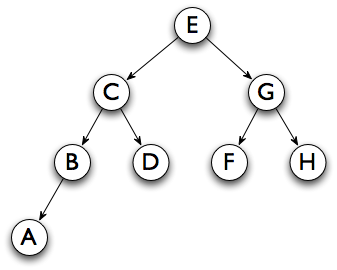(8 points) Weiss Problem 5.21 [5.16]. You only need to do
the
analysis, not an implementation. This one is more complex than previous
problems of this type. As with our analysis of the cubic
algorithm for MCSS in class, you should first derive a (closed-form,
no-summation notation) formula for the exact number of times that the
sum++ statement executes. Be sure
to explain what you are doing, not just write equations. Use your
derived formula to state a big-Theta estimate; you can use the usual
shortcut of dropping lower-order terms and constant factors only at
this last stage.
You do not have to implement and run the code.
(7 points) It is useful to have a unique representation
of binary trees that can be written compactly. For simplicity, we
assume that each node of the tree will contain one
Character. We represent a tree by a pair of strings, which
I call chars and children.
The chars is a pre-order
listing of the contents of the nodes. The children
string tells about the children of the
corresponding node from chars as follows:
| 2 | The node has two children. |
| 0 | The node has no children. |
| L | The node only has a left child. |
| R | The node only has a right child. |
For example:
chars = "+a*-bcd"; children = "2022000";
represents the tree in Weiss Figure 18.11 (a)
chars = "7215349"; children = "220LR00";
represents the tree in Weiss Figure 19.4 (a).
-
What are the values of
charsandchildrenfor the tree below?
-
For a different tree we have:
chars = "THEQUICKBROWN";
children = "2R220002R0RL0";Show the order of the nodes in an in-order traversal of the tree.
(7 points) Hint: use the given info to draw the tree!
THEQUICKLAZYFOX is the
pre-order traversal of a tree (one character per node).
QIUCEHLAZKFYTXO is the
in-order traversal of the same tree.
What is the order of the nodes in the level-order traversal of this tree?
